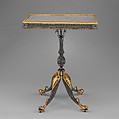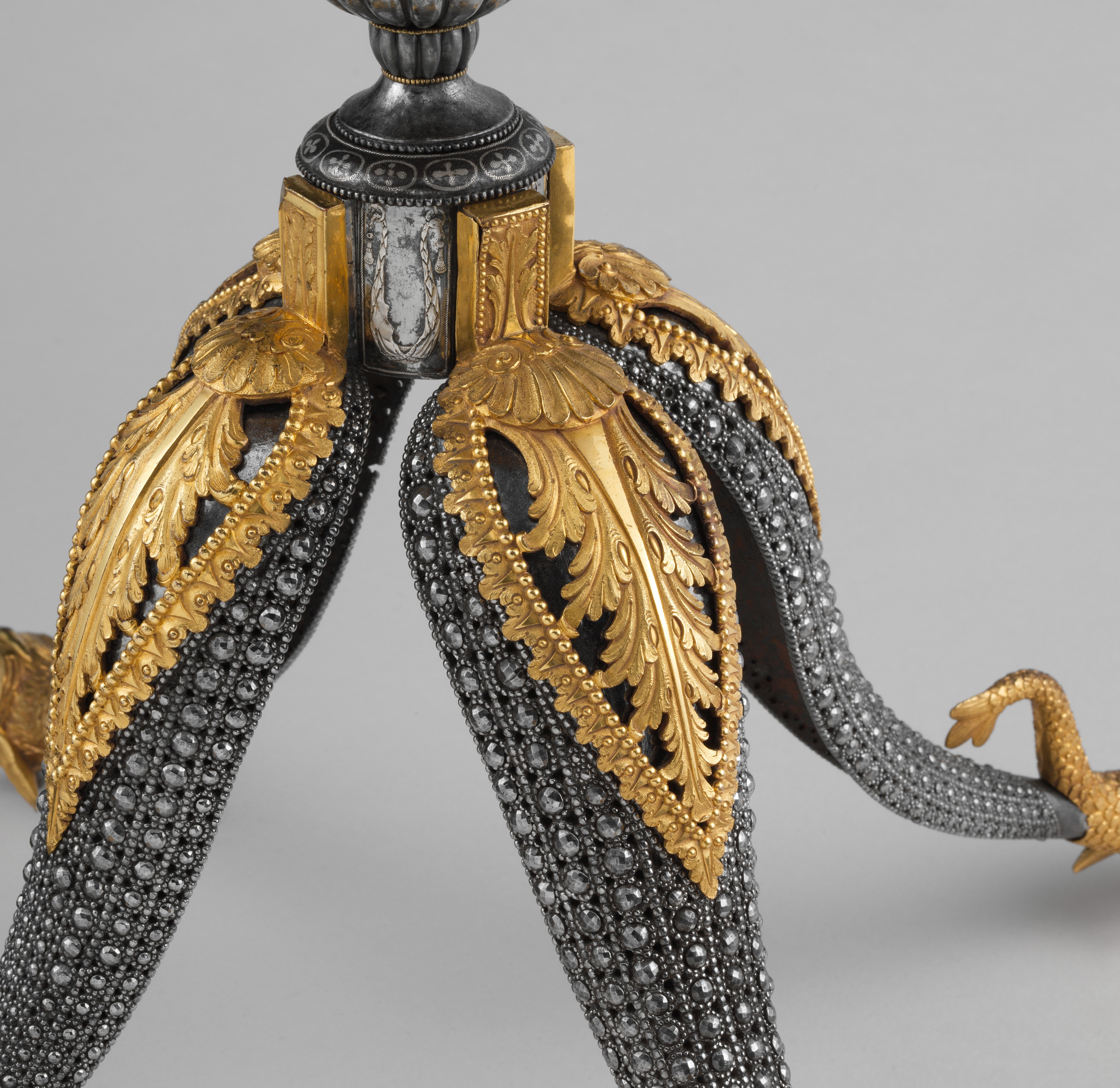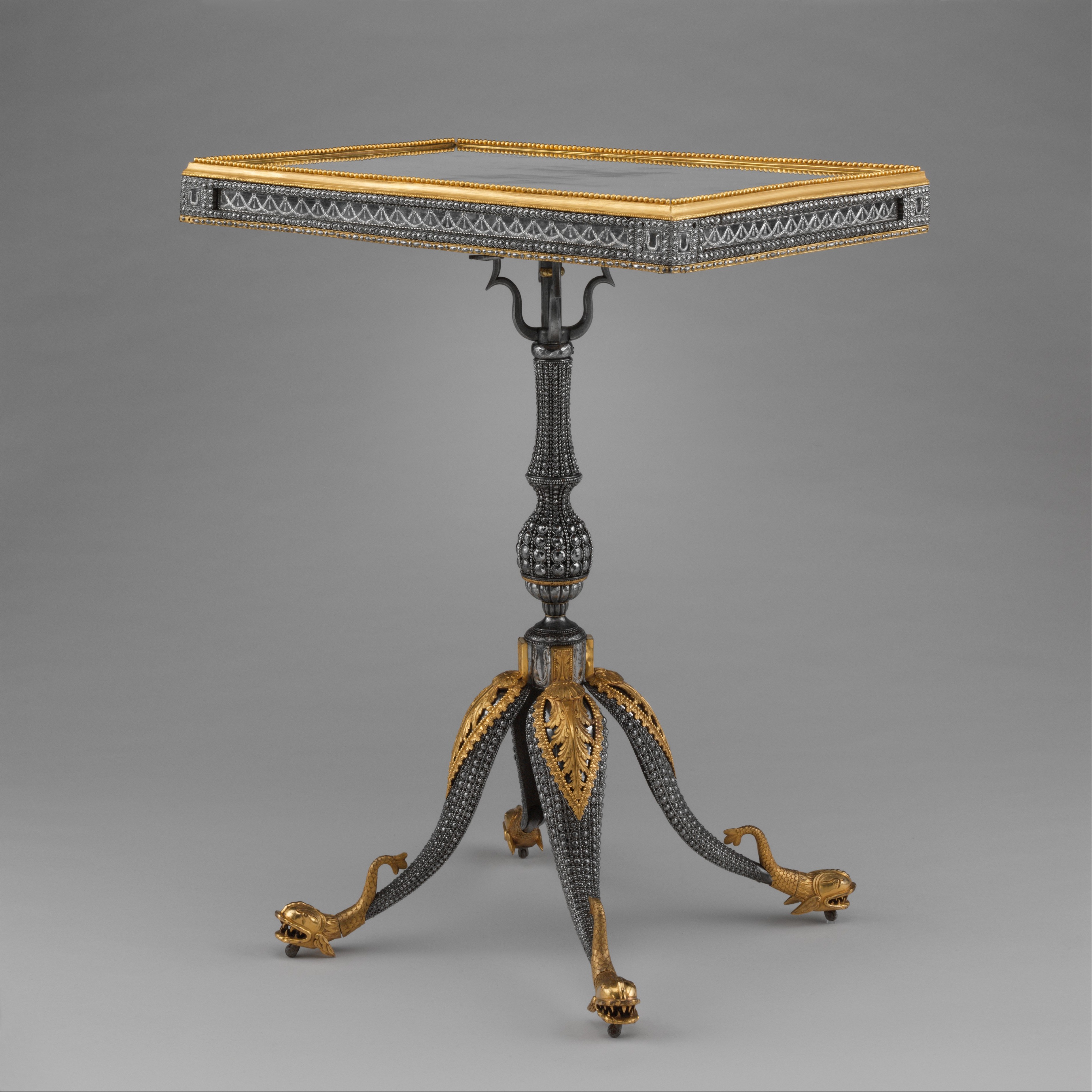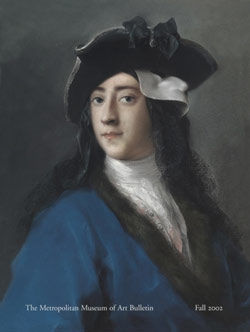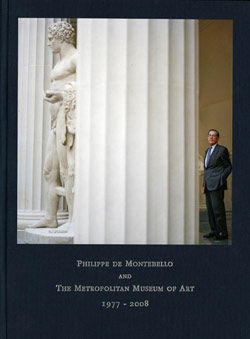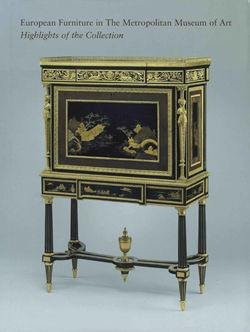Center table
Manufacturer Imperial Armory, Tula (south of Moscow), Russia
From 1712, when the imperial armory in the town of Tula, south of Moscow, was founded by Peter the Great (r. 1682–1725), the master armorers regularly enjoyed imperial patronage.[1] During the reign of Empress Elizabeth (1741–61), they began to produce a sideline of cut-steel decorative items and furniture now known as Tula ware. These were richly and elaborately worked using many different techniques in addition to the faceting that gives them their characteristic diamond-like sparkle. Although in their shapes Tula chairs, tables, and stools resemble traditional wooden furniture, they are chased, blued, chiseled, gilded, pierced, and inlaid like parade weapons. They have come to embody for the eighteenth century the Russian decorative arts, as Fabergé objects have for the decades just before and after 1900.[2] So greatly admired was Tula ware in Western Europe that around 1775 its steel-cut look was imitated in silver and silver-gilt by Augsburg goldsmiths.[3]
In 1785 Empress Catherine the Great, during whose reign (1762–96) the Tula factory flourished, sent two of the armory's most experienced steelworkers to England in order to hone their skills and broaden their creative outlook and ideas; however, English pattern books such as Thomas Chippendale's The Gentleman and Cabinet-Maker's Director (1754) were already in circulation among Russian cabinetmakers.[4] The most imaginative pieces of Tula furniture-objects like the Museum's table-were either delivered directly to Catherine the Great or purchased by her and her family or at the annual Sofia Spring Fair near the palace of Tsarskoye Selo. Made in a cooperative effort by designers and specialist craftsmen, such illustrious pieces were seen as objets d'art and were intended for display and not for daily use. So great was Catherine's passion for these fabulous objects that in 1775 she merged her Tula ware collection of several hundred pieces with some of the crown jewels and placed them together in a special jewelry gallery at the Winter Palace.[5] The empress loved the reflection of light from the thousands of cut-steel facets that caught the rays of the sun by day and the flickering light of candles by night.
Catherine's son and successor, Paul I (r. 1796–1801), who disliked his mother's taste in many ways, did, to some extent at least, share her love of Tula ware. As grand duke, he and his second wife, Sophia-Dorothea of Württemberg (1759–1828), called in Russia Maria Feodorovna, ordered "two chandeliers" and "a stool and several other objects" between 14 May and 7 July 1786, from the Tula armorer Simeon Samoelov (Samarin) for Pavlovsk Palace, near Saint Petersburg.[6]
When the Museum's table appeared at auction in 2001, the sale catalogue correctly identified the branded initial "P" as the mark of Duke Peter Friedrich Ludwig of Oldenburg (r. 1785–1829); however, there is one misconception in the catalogue—that Duke Peter might have purchased the table on one of "his visits to his Russian cousins."[7] Tula ware of such high quality was not offered for public sale; rather, such furniture would have left Russia only as a diplomatic gift or as part of an imperial dowry or a present within the imperial family. The Museum's table was most likely acquired by Catherine the Great herself about 1780–85. It is later recorded, together with furniture by Henri Jacob (1753–1824) and David Roentgen (1743–1807), in an inventory of Pavlovsk Palace in 1801. Among the furnishings in Maria Feodorovna's bedroom is listed "a one-legged table with four whale-feet supporting a rectangular top, with steel diamonds and cut silver."[8] Next to this entry is an annotation in another hand: "Given as a gift to the duke of Golsteen [Holstein] by her Majesty, the Empress."[9] This note contains a crucial clue as to how the imperial table left Russia. Duke Peter and his older brother, Wilhelm August, were born princes of Holstein-Gottorp. Their father's sister, Johanna Elisabeth, was the mother of Catherine the Great, who was born a princess of Anhalt-Zerbst, a family not particularly wealthy but ancient and distinguished.
When Wilhelm was killed in an accident at sea, Peter was next in line to rule the dukedom of Oldenburg. The province had been until recently part of the inheritance of Grand Duke Paul. Following the wish of his mother, Catherine, in 1773 Paul transferred Oldenburg to the house of Holstein-Gottorp in order to provide their "poor" cousins "with a solid and suitable estate."[10] Nevertheless, the dukes of Oldenburg had to acknowledge the feudal jurisdiction of the Russian emperor, since he was in theory the head of the state.[11] After the assassination of Paul on 23/24 March 1801, Duke Peter traveled to Russia, doubtless to pay homage to the new czar, Alexander I (r. 1801–25), now head of the imperial family. Peter stayed with Maria Feodorovna at Pavlovsk Palace from 21 May until 26 June 1801.[12] Twenty years earlier he had married Friederike von Württemberg, a sister of Maria Feodorovna's. The marriage, a happy one, was cut short when Friederike died in 1785 after childbirth.[13] In a letter to his sister-in-law dated 23 November 1800, the duke, who never remarried, wrote, "Tomorrow it will be fifteen years since our beloved Friederike left us. I know that your Imperial Majesty will think of us."[14] It seems safe to assume that the dowager empress gave the Museum's table as a personal keepsake to her former brother-in-law during his stay at Pavlovsk. The empress had herself just become a widow and must have felt gratitude and affection for Peter, who had devoted himself to the upbringing of his two sons, her nephews.[15] In this connection, it is interesting to note that before returning to Oldenburg Duke Peter bought an extra wagon to transport home the things he had acquired during his stay in Saint Petersburg.[16]
The Museum's table belongs to a very small group of Tula furniture embellished with silver inlay, ornamental etching, and gilded applications. It includes a dressing table with chair in the pure Neoclassical taste presented by the town of Tula to Catherine the Great on the occasion of the empress's visit in 1787. She gave it in 1788 to Maria Feodorovna, and it is still preserved in the public rooms at Pavlovsk Palace.[17] Closest in style to the Museum's table is one in Catherine's bedroom at the Catherine Palace in Tsarskoye Selo; its stand still reflects the influence of English Rococo forms, but its top and decoration are Neo-classical.[18] Another example, with a rectangular top and four tapering legs, is in Pavlovsk.[19] Two slightly earlier examples, with round tops in the "Chippendale style," are in the State Hermitage Museum, Saint Petersburg.[20] The table in the Metropolitan is technically the most accomplished and visually the most exciting example. The astonishing disparity between the heavy and recalcitrant materials and the light and airy form that seems to float on the surface of the sea, supported by golden whales, makes this table a supreme masterpiece.[21]
[Wolfram Koeppe 2006]
I thank Mechthild Baumeister, Linda Borsch, Olga Kostiuk, Marina Nudel, and Stuart Phyrr for their help with this entry. I am most grateful to H.R.H. Dr. Philipp, duke of Württemberg, for his advice. Special thanks are also due to H.R.H. Christian, duke of Oldenburg, for discussing the history of this table with me and for allowing me to consult Oldenburg family documents at the Staatsarchiv in Oldenburg.
Footnotes:
1. Mariia Danilovna Malchenko. Art Objects in Steel by Tula Craftsmen. Leningrad, 1974, p. 5, figs. 5-7.
2. Other typically Russian national arts are stone cutting, associated with the Imperial Glass and Lapidary Works in Saint Petersburg, and the walrus-ivory carving done at Arkhangel'sk. On the latter, see "Recent Acquisitions: A Selection, 1997–1998." The Metropolitan Museum of Art Bulletin 56, no. 2 (Fall 1998), p. 39 (entry by Marina Nudel).
3. A pair of silver candlesticks in the Tula taste by the famous Biller family of Augsburg goldsmiths was shown by the Galerie Neuse, Bremen, at the TEFAF antiques fair, Maastricht, in 1998.
4. Mariia Danilovna Malchenko. Art Objects in Steel by Tula Craftsmen. Leningrad, 1974, pp. 14-16.
5. St. Petersburg Jewellers, Eighteenth–Nineteenth Centuries/Petersburgskie iuveliry, XVIII–XIX veka. Exh. cat., State Hermitage Museum. Saint Petersburg, 2000, p. 8 (showcase at lower left).
6. Archives, State Museum Pavlovsk, doc. A-20/4, pp. 5-6 (for 1786), cited in Anatolii Mikhailovich Kuchumov. "Tul'skie stal'nye izdeliia v urbranstve Pavlovskogo dvortsa (Works in steel from Tula in the interiors of Pavlovsk Palace). In Anatolii Mikhailovich Kuchumov, Stat'i, vospominaniia, pis'ma (Essays, memoirs, letters), pp. 136–42. Pavlovsk: Istoriia i sud'by. Saint Petersburg, 2004.
7. Catalogue of a sale at Christie's, London, 13 December 2001, p. 126, lot 500.
8. Archives, State Museum Pavlovsk, inventory of Pavlovsk Palace, 1801, p. 32. See "Recent Acquisitions: A Selection, 2001–2002." The Metropolitan Museum of Art Bulletin 60, no. 2 (Fall 2002), p. 25 (entry by Wolfram Koeppe); Anatolii Mikhailovich Kuchumov. "Tul'skie stal'nye izdeliia v urbranstve Pavlovskogo dvortsa (Works in steel from Tula in the interiors of Pavlovsk Palace). In Anatolii Mikhailovich Kuchumov, Stat'i, vospominaniia, pis'ma (Essays, memoirs, letters), pp. 136–42. Pavlovsk: Istoriia i sud'by. Saint Petersburg, 2004, pp. 139-40, n. 10 (in which the table is mentioned); and Wolfram Koeppe. "The Oldenburg Table." Weltkunst 75 (2005), pp. 188–92. 75th anniverary issue, pt. I.
9. Anatolii Mikhailovich Kuchumov. "Tul'skie stal'nye izdeliia v urbranstve Pavlovskogo dvortsa (Works in steel from Tula in the interiors of Pavlovsk Palace). In Anatolii Mikhailovich Kuchumov, Stat'i, vospominaniia, pis'ma (Essays, memoirs, letters), pp. 136–42. Pavlovsk: Istoriia i sud'by. Saint Petersburg, 2004, p. 140, n. 10.
10. Staatsarchiv, Oldenburg, Best. 7, Urk. 1773, Juli 19/30; see Hülle 1972, p. 45.
11. Following the protocol, the Annual Chronicle of Oldenburg published during these years documents all the public activities of the Russian imperial household before recording local events (reviewed by this author at the Staatsarchiv, Oldenburg).
12. Staatsarchiv, Oldenburg, Best. 6D, no. 25.
13. Herzog Peter Friedrich Ludwig von Oldenburg (1755–1829). Exh. cat., Landesmuseum Oldenburg. Veröffentlichungen der Niedersächsischen Archivverwaltung, suppl. 22. Göttingen, 1979, pp. 34-37, nos. 15, 16.
14. Johann Heinrich Hennes. Friedrich Leopold, Graf zu Stolberg, und Herzog Peter Friedrich Ludwig von Oldenburg: Aus ihren Briefen, und anderen archivalischen Quellen. Mainz, 1870. Repr., Bern, 1971, p. 524.
15. Herzog Peter Friedrich Ludwig von Oldenburg (1755–1829). Exh. cat., Landesmuseum Oldenburg. Veröffentlichungen der Niedersächsischen Archivverwaltung, suppl. 22. Göttingen, 1979, pp. 8-9.
16. A detailed estimate provided by the duke's adjutant lists all the transport costs, including money "to bribe the Danish customs" (Staatsarchiv, Oldenburg, restricted Oldenburg family papers). Three pieces by David Roentgen, all bearing the crowned P, were most likely part of the gift; see catalogue of a sale at Christie's, Schloss Anholt, 20-21 November 2001, lots 570-72. One of them, an architect's table, is today in a private collection in New York.
17. Alexandra Vassilievna Alexeieva. "Furniture." In Pavlovsk, ed. Emmanuel Ducamp, vol. 2, The Collections, pp. 92–115. Paris, 1993, p. 92; and Krieg und Frieden: Eine deutsch Zarin in Schloss Pawlowsk. Exh. cat., Haus der Kunst, Munich. Munich and Hamburg, 2001, pp. 342-43, nos. 213-16 (entry by Olga Bashenowa).
18. The table is illustrated in color in Antoine Chenevière. Russian Furniture: The Golden Age, 1780–1840. London, 1988, p. 247, pl. 266.
19. Krieg und Frieden: Eine deutsch Zarin in Schloss Pawlowsk. Exh. cat., Haus der Kunst, Munich. Munich and Hamburg, 2001, p. 343 (on the left).
20. Mariia Danilovna Malchenko. Art Objects in Steel by Tula Craftsmen. Leningrad, 1974, figs. 15, 16.
21. The table was restored in 2003 by Linda Borsch, Conservator, Department of Objects Conservation, Metropolitan Museum. She replaced a thick gilded-wood molding on the top with a beaded frame that was adapted from an original eighteenth-century piece in the Museum's gilt-bronze collection; see the conservation report in the archives of the Department of European Sculpture and Decorative Arts, Metropolitan Museum.
Due to rights restrictions, this image cannot be enlarged, viewed at full screen, or downloaded.
This artwork is meant to be viewed from right to left. Scroll left to view more.
